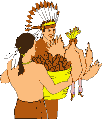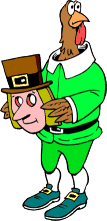|

 Thanksgiving
falls on the fourth Thursday Thanksgiving
falls on the fourth Thursday
of November.
It is a day observed for giving thanks
to God for one's blessings.

 The
Pilgrims, The
Pilgrims,
 a
group of English protestant worshipers,
came to the New world seeking religious freedom. The Pilgrims,
originally called separatists, later called Puritans, wanted to purify the
teachings and ceremonies of the Church of England. a
group of English protestant worshipers,
came to the New world seeking religious freedom. The Pilgrims,
originally called separatists, later called Puritans, wanted to purify the
teachings and ceremonies of the Church of England.
King James I, the ruler of England would not recognize their
rights to worship as they wished and they were punished and persecuted. Many
sought refuge in the Netherlands and moved there in an effort to worship freely.
However, they missed English Life and customs and many of them, when given the
opportunity to go to the New World, America, gladly did
so.
They bordered the Mayflower on September 16, 1620 and landed off the coast of
Cape Cod in Provincetown
Harbor on November 21, 1620, sixty-six days after setting sail. A month later, under
the leadership of Miles Standish, they chose a place to establish their colony
and named it Plymouth, for the city in England from where they set sail.
on September 16, 1620 and landed off the coast of
Cape Cod in Provincetown
Harbor on November 21, 1620, sixty-six days after setting sail. A month later, under
the leadership of Miles Standish, they chose a place to establish their colony
and named it Plymouth, for the city in England from where they set sail.
T he Mayflower Compact,
the first governing agreement ever put forth in America was written by the
Pilgrims, before they ever set foot on land.
It set up the rules for governing
the colony they would establish and did in December of 1620.
More than half of the colony died
that
winter of 1621.
But, in the spring with the help of the Native Americans

(or American Indians)
who gave them seeds, showed them
how to plant and introduced them to corn, the
survivors were able to continue the colony
and reap a
 harvest
in the fall. harvest
in the fall.
The first Thanksgiving
 was
observed that fall in 1621 to give thanks for their survival and their blessings
especially, was
observed that fall in 1621 to give thanks for their survival and their blessings
especially,
the freedom of worship.
Indians brought corn and wild
turkeys for the feast.
The colonists made journey cakes, corn meal bread,
nuts and succotash.
The Pilgrim men killed geese, ducks and fish.
Later, Governor William Bradford decreed a
three day feast
on July 30, 1623 for Thanksgiving observation.
 The custom spread from Plymouth
The custom spread from Plymouth

throughout the
New England colonies.
During the American Revolution eight days of thanks
were
observed, praying for victory over the British.
George Washington issued a
general proclamation
naming November 26 a day of National Thanksgiving in 1789.
The Episcopalian Church announced that the first Thursday in November would be
an annual day of giving thanks.
There was not a National Day of Thanksgiving recognized throughout the United
States for many years.
Some recognized and observed a day while others did not.
In 1830 New York declared an official state Thanksgiving,
other northern states
followed it's example.
Virginia was the first southern state to adopt a
Thanksgiving Day in 1855.
In 1863, President Lincoln proclaimed the last
Thursday
in November as a day of thanksgiving and praise.
Mrs. Sarah Joseph Hale
worked many years to promote
a national Thanksgiving Day.
Thanksgiving Day for
the next 75 years
was then celebrated on the last Thursday in November
as
proclaimed by each president.
However, in 1941 Congress ruled the
fourth Thursday of November
would now, be a
federally recognized holiday.
It has been celebrated as such ever since that
time.
 The
American Thanksgiving Day The
American Thanksgiving Day
probably grew out of the harvest home celebrations
observed in England. One of
the first observances
of thanksgiving prayers was observed by
39 English
settlers on Berkeley James Plantation,
on the river near what is now called,
Charles City, Virginia.
Their charter called for the day of their arrival,
December 4, 1619 to be observed annually,
as a day
of Thanksgiving to God.
Thanksgiving
 is celebrated is celebrated
with great
 dinners, dinners,
prayers and
visits among friends and families.
Parades and football games
are some of the
events enjoyed on the day as well.

Thanksgiving Day Puzzles:


KidsPuzzles
Middies and
 Elders
Activities: Elders
Activities:

Kid's Poetry:

To Thanksgiving
Day
Activity
Page Thanksgiving
Day
Activity
Page

Barnyard
Thanksgiving Holiday Play!

|


![]() Fly
Home
Fly
Home
![]() Eggsite
Eggsite
![]() Activities
Activities
![]() Puzzles
Puzzles
![]() Links
Links